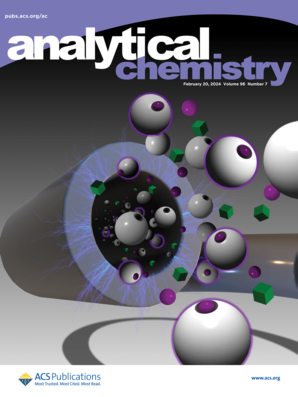Lab-on-Robot: Unmanned Mass Spectrometry Robot for Direct Sample Analysis in Hazardous and Radioactive Environments
IF 6.7
1区 化学
Q1 CHEMISTRY, ANALYTICAL
引用次数: 0
Abstract
Onsite, safe, and reliable mass spectrometry (MS) analysis of hazardous and radioactive samples plays a crucial role in timely chemical emergency management and response in real environments. The current study reports the development of a smart MS robot by integrating miniature MS, quadruped robot, switchable robotic arm sampler, and direct ionization for remote-controlled chemical analysis of complex samples in inaccessible hazardous and radioactive environments. High automation and excellent analytical performance have been achieved in the real-time analysis of volatile toxic substances in air and onsite detection of explosive particles in air aerosols. Successful detection of hazardous compounds has been performed from raw wastewater. The chemical analysis of radioactive ore samples has also been demonstrated. Low limits of detection at ng/g or ng/mL (signal-to-noise ratio, S/N = 3) and good relative standard deviation (RSD < 12.0%, n = 6) were obtained by the MS robot for analyzing different gaseous, aerosol, liquid, and solid samples. The remote detection results of the MS robot were further validated. The reported study encourages the future development of a smart lab-on-robot, which functions with smart operation to replace the traditional laboratory procedures for MS analysis of dangerous chemical and environmental samples.

机器人实验室:用于危险和放射性环境中直接样品分析的无人质谱机器人
现场、安全、可靠的危险和放射性样品的质谱(MS)分析在真实环境中及时的化学应急管理和响应中起着至关重要的作用。目前的研究报告了一种智能质谱机器人的开发,该机器人集成了微型质谱、四足机器人、可切换的机械臂取样器和直接电离,用于在难以接近的危险和放射性环境中对复杂样品进行远程控制化学分析。在空气中挥发性有毒物质的实时分析和空气气溶胶中爆炸性颗粒的现场检测中,实现了高度自动化和优异的分析性能。已成功地从原废水中检测出有害化合物。放射性矿石样品的化学分析也得到了证实。低检测限为ng/g或ng/mL(信噪比,S/N = 3),良好的相对标准偏差(RSD <;12.0%, n = 6),由质谱机器人分析不同的气体、气溶胶、液体和固体样品。进一步验证了MS机器人的远程检测结果。报告的研究鼓励了智能机器人实验室的未来发展,它具有智能操作功能,以取代传统的实验室程序,用于危险化学品和环境样品的质谱分析。
本文章由计算机程序翻译,如有差异,请以英文原文为准。
求助全文
约1分钟内获得全文
求助全文
来源期刊

Analytical Chemistry
化学-分析化学
CiteScore
12.10
自引率
12.20%
发文量
1949
审稿时长
1.4 months
期刊介绍:
Analytical Chemistry, a peer-reviewed research journal, focuses on disseminating new and original knowledge across all branches of analytical chemistry. Fundamental articles may explore general principles of chemical measurement science and need not directly address existing or potential analytical methodology. They can be entirely theoretical or report experimental results. Contributions may cover various phases of analytical operations, including sampling, bioanalysis, electrochemistry, mass spectrometry, microscale and nanoscale systems, environmental analysis, separations, spectroscopy, chemical reactions and selectivity, instrumentation, imaging, surface analysis, and data processing. Papers discussing known analytical methods should present a significant, original application of the method, a notable improvement, or results on an important analyte.
 求助内容:
求助内容: 应助结果提醒方式:
应助结果提醒方式:


